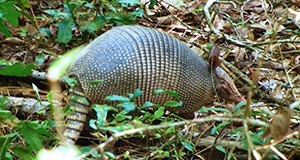Abstract
Worldwide, 250,000 new cases of leprosy are reported each year, and in the United States, approximately 150 new cases of leprosy are diagnosed each year. Also known as Hansen’s disease, leprosy (Mycobacterium leprae) is a bacterial disease that infects the skin and nerves, causing disfiguring skin sores, nerve damage, and occasionally lung damage if left untreated. Leprosy is spread between humans via respiratory droplets when people sneeze or cough. In the southeast United States, handling armadillos is thought to be the source of many infections. This 4-page fact sheet describes the disease in humans and armadillos and explains how to avoid it and limit its spread. Written by Shannon P. Moore and Samantha M. Wisely, and published by the Wildlife Ecology and Conservation Department, December 2015.
References
Centers for Disease Control and Prevention. Centers for Disease Control and Prevention, 29 Apr. 2013.
Glenza, Jessica. "Three Cases of Leprosy in Eastern Florida 'linked to Armadillos'." The Guardian. The Guardian, 27 Feb. 2015.
"Hansen's Disease Data & Statistics." Hansen's Disease Data & Statistics.
"Leprosy in U.S. May Be Transmitted by Armadillos, Study Finds." Leprosy in U.S. May Be Transmitted by Armadillos, Study Finds. U.S. Department of Health and Human Services, 27 Apr. 2011.
"Leprosy." World Health Organization.
"National Hansen's Disease (Leprosy) Program Caring and Curing Since 1894." National Hansen's Disease (Leprosy) Program Caring and Curing Since 1894. U.S. Department of Health and Human Services.
Pelican, Garrett. "Floridians Urged to Avoid Leprosy-Infected Armadillos." USA Today. USA Today, 22 July 2015.
Schaefer, Joseph M., and Mark E. Hostetler. "The Nine-Banded Armadillo (Dasypus Novemcinctus)." EDIS New Publication. University of Florida IFAS Extension.
Sharma, Rahul, Pushpendra Singh, W.J. Loughry, J. Mitchell Lockhart, W. Barry Inman, Malcom S. Duthie, Maria T. Pena, Luis A. Marcos, David M. Scollard, Stewart T. Cole, Richard W. Truman. "Zoonotic Leprosy in the Southeastern United States." Emerging Infectious Diseases. Center for Disease Control, Dec. 2015. https://doi.org/10.3201/eid2112.150501
Truman, Richard W., Pushpendra Singh, Rahul Sharma, Philippe Busso, Jacques Rougemont, Alberto Paniz-Mondolfi, Adamandia Kapopoulou, Sylvian Brisse, David Scollard, Thomas Gillis, and Stewart Cole. "Probable Zoonotic Leprosy in the Southern United States - NEJM." New England Journal of Medicine. New England Journal of Medicine, 28 Apr. 2011. https://doi.org/10.1056/NEJMoa1010536

